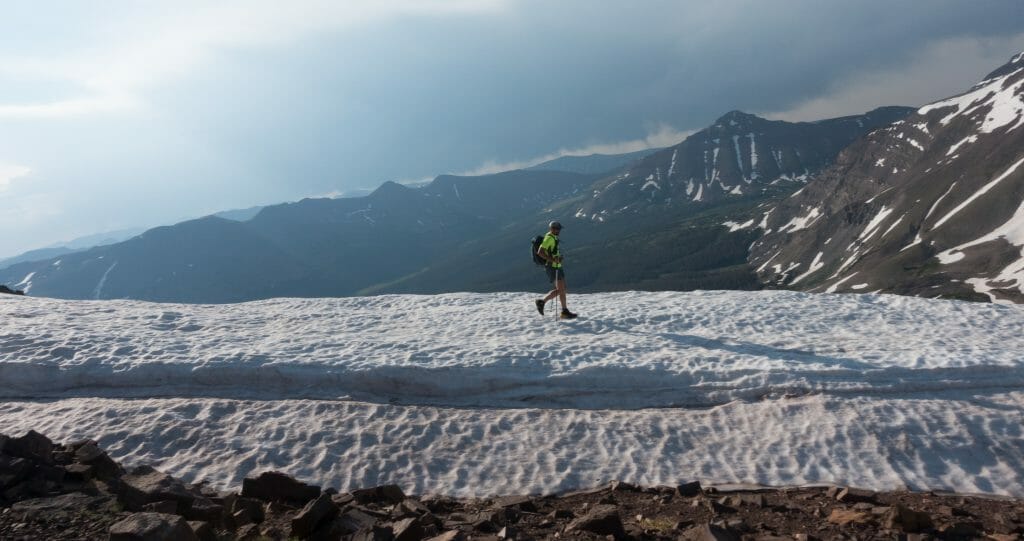Professional mountain runner Luke Nelson has raced all over the world since getting into the sport a decade ago. He won the 2014 Bighorn Trail 100, came in second in the 2011 Wasatch Front 100-Mile Endurance Run, and placed third in the 2016 US Skyrunner Series. At his racing peak, he averaged one race a month from April through October, with a couple 100-milers and a passion project or two shoehorned in. These days he prefers to trace his own lines, but the same principles that once guided his race season planning still apply—and they’re helpful for all runners looking ahead to spring, summer, and fall objectives.
Tips for Race Season Planning
Go for what excites you.
For me the events that are most appealing are either aesthetic courses—courses in beautiful places—or challenging courses, in terms of terrain or environment. The Rut in Montana is one of my favorite races. Ranking a close second and third are Tromsø, a skyrace in Norway that Kilian Jornet and Emelie Forsberg put on, and the Glen Coe Skyline in Scotland. All three are technical mountain races: they involve moving through mountains and over summits on routes that would be pretty exciting to go do on your Saturday long run. But most people don’t go to Norway for their Saturday long run.
You can generalize this out to just about any trail runner: pick the races that inspire you. For me those are technical races like The Rut. For someone else that might be 50 miles of flat, runnable singletrack. Signing up for a race that inspires you really adds to the motivation of training, and you’ll enjoy the event instead of just slogging through it.
Do plenty of Googling.
To discover new races, I consult trip reports that runners have either written for sponsors or posted to their personal websites. For me a race needs to be visually stimulating, so sometimes the pictures alone are enough to pique my interest. Another great resource is UltraSignup, the major trail race registration site in the United States. They can recommend races similar to other races you’ve done that are in different parts of the country.
Plan your race season early.
Depending on the length of the race you’re interested in, start thinking about mapping out your calendar as much as a year in advance. And consider having multiyear goals, like picking a pinnacle race you want to do really well at, but may need a season or two to appropriately build up your fitness and endurance to be successful. I think all too often people sign up for a race on a whim. Sure, you can gut it out. But to have the best experience, start planning and training at a minimum six months ahead, if not longer than that.

Luke Nelson out for an evening run on the Hardrock course, San Juans, Colorado.
Read the fine print.
Physical preparation aside, there’s also a practical concern to getting a head start on your planning. With trail and ultrarunning gaining in popularity, races—especially the more well-known ones—tend to fill up quickly, sometimes within an hour or two of registration opening up. There are lotteries and wait lists and plenty of runners who miss out on spots in events they’re gunning to do. If your heart is set on a big-name race, make sure you know the exact time when registration is going to open, and get your name in the second it does.
On top of that, some races require you to have completed another race of a certain distance in order to qualify for the race you want to do. Maybe you need to have finished a 50K to qualify for a 50-miler, or maybe you need to prove you have the technical know-how to tackle a more rugged course. Do your research well in advance, and cover your bases when it comes to these prerequisites.
Balance your races so that they aren’t all the main event.
When I did more racing, my coach and I would structure my calendar so that not all of the events I signed up for would be my main focus. Instead, I would do certain races as part of my training to get ready for bigger “goal” races. A good example of that would be in 2016 when I did the Sky Extreme World Series, which included the Norway and Scotland races I mention above. To prepare for those longer objectives overseas, I used the US Skyrunner Series in the shorter distances as training. No disrespect to those events, but that year the primary objective was to do well in Europe. So the calendar was still full, but I trained up to and through the shorter US-based races.
Don’t overdo it.
That strategy of using races as training can be beneficial, but it has to be applied very cautiously. If not, you risk going too hard in the stepping-stone events and getting overtrained. I was racing sky-distance races, which are shorter efforts—much shorter than the pinnacle races I was trying to do—and that allowed me to race hard without the same impact as one of the Extreme Series ultramarathons. Had I been trying to do the ultra distances in the US series, it would have been too much and I would have seen decreasing performance as the season went on. I just can’t recover that well every three to four weeks.
It’s really helpful to look at what the very best marathoners in the world do: they race two marathons in a year. What makes us as ultramarathoners think we can race six and have top-level performances? It’s a reality check.
Have fun along the way.
Runners often fixate on race goals, but healthy training can have some really fun events baked into it. Get out into the mountains—and enjoy being out there—as part of the training process for big objectives. Training shouldn’t be a grind. People often think of races as the only times when they get together with the community and have a lot of fun, but you can have just as much fun getting together with a group of friends and doing a long run in the mountains on the weekend. That can easily fit into a well-structured training plan.
Further reading:
Confronting the Impossible at the Tor des Geants
Unstructured Consequences: Luke Nelson’s Hard-Earned Lessons in Planning

